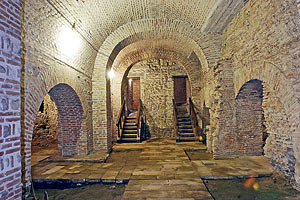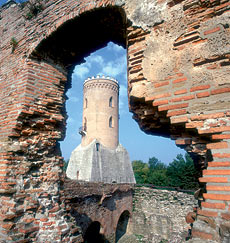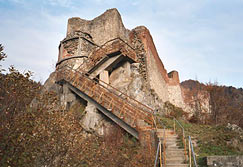Bucharest
Known for its wide, tree-lined boulevards, glorious Belle Époque buildings and a reputation for the high life (which in the 1900s earned its nickname of “Little Paris”), Bucharest, Romania's largest city and capital, is today a bustling metropolis. Bucharest is laden with charm – from the streets of the Old City Center, which are slowly being restored, to the grand architecture of the Royal Palace and the lush green of Cismigiu Park. The city also claims a large number of museums, art galleries, exquisite Orthodox churches and unique architectural sites.Old Princely Court
 At the center of the historic area in Bucharest are the remains of the Old Princely Court, built in the 15th century by Vlad Tepes. According to local lore, Vlad kept his prisoners in dungeons which commenced beneath the Old Princely Court and extended under the city. All that remains today are a few walls, arches, tombstones and a Corinthian column.
At the center of the historic area in Bucharest are the remains of the Old Princely Court, built in the 15th century by Vlad Tepes. According to local lore, Vlad kept his prisoners in dungeons which commenced beneath the Old Princely Court and extended under the city. All that remains today are a few walls, arches, tombstones and a Corinthian column.The Old Court Museum was established in 1972 when an archaeological dig revealed the remains of the fortress, along with Dacian pottery and Roman coins, evidence of Bucharest’s earliest inhabitants. The oldest document attesting to the city’s origin under the name of Bucuresti was discovered here. It was issued on September 20, 1459 and signed by Prince Vlad Tepes.
Next to the palace stands the Old Court Church (Biserica Curtea Veche), dating from 1559 and considered the oldest in Bucharest. For two centuries, the church served as coronation ground for Romanian princes. Some of the original 16th century frescoes have been preserved.
Snagov Monastery
Where: 25 miles north of Bucharest
Nearest train station: Bucuresti Nord
One hundred years after the church at Snagov was built (1364), Vlad Tepes added fortress walls and a dungeon. A plaque on the floor of the church marks the grave with the presumed remains of the ruler. The monastery, located on an island on the far side of the lake, can only be accessed by boat.
Nearest train station: Bucuresti Nord
One hundred years after the church at Snagov was built (1364), Vlad Tepes added fortress walls and a dungeon. A plaque on the floor of the church marks the grave with the presumed remains of the ruler. The monastery, located on an island on the far side of the lake, can only be accessed by boat.
Targoviste – Princely Court
In Targoviste, tour the 14th centuryPrincely Court and Chindiei Watchtower(Turnul Chindiei). The Princely Court served as the capital of Walachia, where Vlad ruled. It was here that the Prince impaled a great many disloyal court members (the boyars) after inviting them to a celebratory feast. Chindiei Watchtower now houses an exhibition illustrating Vlad's life.
Poenari Fortress
Where: 108 miles northwest of Bucharest /15 miles north of Curtea de Arges
Note: access by car only
The ruins of Poienari Fortress stand high on a cliff overlooking the Arges River, at the foothills of the Carpathian Mountains. Built at the beginning of the 13th century by the first Walachian rulers, the castle changed names and residents a few times over the decades; eventually, it was abandoned and left in ruins. Vlad recognized the potential of the location and upon taking over the throne, he ordered that the structure be repaired and consolidated, turning it into one of his main fortresses. When the Turks attacked and captured the castle in 1462, Vlad escaped via a secret passageway leading north through the mountains. Although the castle was used for many years after Vlad's death in 1476, it was eventually abandoned again in the first half of the 16th century and left to the ravages of time and weather. In 1888, a major landslide brought down a portion of the castle which crashed into the river far below. The castle underwent repairs and the remnants of its walls and towers stand to this day.
You will need stamina to climb the 1,462 steps to reach the castle ruins, perched high above the surrounding area like an eagle's nest.
Note: access by car only
The ruins of Poienari Fortress stand high on a cliff overlooking the Arges River, at the foothills of the Carpathian Mountains. Built at the beginning of the 13th century by the first Walachian rulers, the castle changed names and residents a few times over the decades; eventually, it was abandoned and left in ruins. Vlad recognized the potential of the location and upon taking over the throne, he ordered that the structure be repaired and consolidated, turning it into one of his main fortresses. When the Turks attacked and captured the castle in 1462, Vlad escaped via a secret passageway leading north through the mountains. Although the castle was used for many years after Vlad's death in 1476, it was eventually abandoned again in the first half of the 16th century and left to the ravages of time and weather. In 1888, a major landslide brought down a portion of the castle which crashed into the river far below. The castle underwent repairs and the remnants of its walls and towers stand to this day.


No comments:
Post a Comment